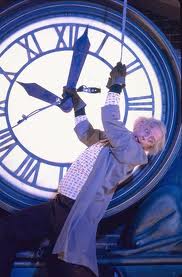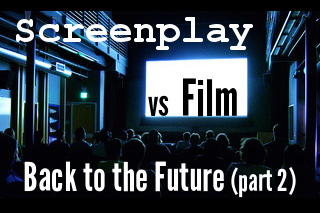Yesterday, I continued this Screenplay vs Film series by describing screenwriting tips learned by comparing the screenplay and film versions of the 80’s classic, Back to the Future — in which Marty McFly travels back in time to 1955 and jeopardizes his existence in 1985.
I learned a lot of screenwriting tips by comparing the two, so yet again, I had to break the post into two parts. If you missed it, click here for the first half of 12 Screenwriting Tips from Back to the Future. Here is the 2nd part.
Screenwriting Tip #7: Give the pretty girl a good reason
In Back to the Future the movie, Marty’s mom, Lorraine, was a very pretty and probably popular girl in high school. His future dad, George, however was a real dweeb. It wouldn’t seem credible for her to date him at all, let alone marry him.
In the 1981 screenplay, no motivation is given for the relationship. Lorraine says yes to Marty’s dad when he asks her to the school dance because the plot required it. Do you really think pretty & popular Lorraine would’ve said yes to the boy who asked her in the cafeteria, spilling his creamed corn all over himself?
In the movie, though, Zemeckis & Gale wisened up. Lorraine and George have their first significant encounter when her dad almost runs him over with his car. She had to take care of him for a little while, and those nursing instincts turned into something more amorous. When Marty tells Doc Brown about how his parents met, Doc says it makes sense: it’s even a scientific phenomenon called the Florence Nightingale effect, where nurses fall in love with their patients.
It gave just the right amount of credibility to Lorraine and George’s romance, and as a bonus, provided some great comedic opportunities when Marty travels to 1955 and Lorraine’s dad almost runs him over instead of George.
Screenwriting Tip #8: Use repetition to your advantage
In the 1985 movie, Marty has several encounters with the villain of the story, the school bully Biff. In the first act, Biff ruins George’s car and blames George for it (the mark of a true tyrant). When Marty travels to 1955, he has a chance encounter with his dad at a local cafe, when Biff enters and bullies George using almost the same exact dialogue from 1985.
The way the 1955 scene echoed the 1985 scene was genius, giving both scenes richer meaning, especially with respect to theme. Without being hit over the head with it, we got the message instantly: if you don’t stand up for yourself, nothing will change.
Keep in mind that if you adopt this screenwriting technique in your own movie, you can’t just repeat the same scene and consider it a day. There should be variation between the two (or even three or four…) that gives the scenes their significance. Study the 1985 and 1955 Biff scenes in Back to the Future to get a feel for how it’s done.
Screenwriting Tip #9: Increase urgency
In the 1985 movie, we feel Marty’s urgency. He HAS to get his parents on the right track romantically. Otherwise, he’ll never be born. The movie highlights this urgency by showing us a photo of the 3 McFly children — and how slowly, but surely, each one disappears from the photo as Lorraine and George deviate from their 1955 past.
In the 1981 screenplay, Doc tells Marty that if George doesn’t ask Lorraine to the dance, Marty won’t be born. Of course this motivates Marty and makes us concerned for his future, but it doesn’t have the urgency that the photo did because we couldn’t see Marty disappearing. I still get tense when I watch the following clip even though I know the ending — that’s powerful storytelling!
Screenwriting Tip #10: Extend the climax
The Earth Angel scene in Back to the Future is not the only time I get nervous for Marty. The clock tower scene where Marty and Doc try to harness the power of the lightening that struck the tower also makes me tense.

Poor Doc!
It’s a really great climactic scene — and here’s the secret to its success. The climax was written as a series of small tasks that had to take place in sequence in order to get Marty back to 1985 — and all of these tasks go wrong. Just as Doc fixes one element, another one goes bust, and we’re tense throughout the whole process.
When you’re writing the climax in your own movie and it seems a little lackluster, see if you can increase the suspense by having a number of small things go wrong with only a little bit of time to correct them. Toy Story 1 & 2 also are great examples of climaxes where the characters fix one element only to discover something else has gone wrong.
Screenwriting Tip #11: MBAs aren’t the only ones who benefit from cost-benefit analysis
Cost-benefit analysis is important for screenwriters too — especially as it applies to setups and payoffs. In the 1981 screenplay of Back to the Future, Zemeckis & Gale spent a lot of time establishing the 1955 world that Marty traveled back to, specifically the city where his parents grew up and where he lives in 1985. But the climax of the screenplay didn’t occur there, oh no. It took place all the way over in Nevada where the government was doing nuclear testing. There was no beloved clock tower in the 1981 screenplay. Instead of lightening, Marty had to use the power of an atomic blast to send him back to 1985.
Because of this, Zemeckis & Gale had to spend time describing this new site — and the army personnel manning it. Sadly, the time spent setting up this climax didn’t pay off. All of this description slowed down the story, which is the last thing you want to happen at your climax. Furthermore, we, the audience, were just suddenly introduced to the cast of army personnel. They weren’t people we had spent time getting to know over the course of the screenplay, unlike Doc and Marty.
As much as possible, keep the characters who we’ve emotionally engaged with as the focus of your climax. Even in large scale climactic scenes like the one found in Lord of the Rings: Fellowship of the Ring, the screenplay highlights the battles of the individual characters we’ve followed throughout the story.
In your own screenplay, if you’ve decided to shift locales after spending a lot of time describing one setting, do a cost-benefit analysis first. Is it really necessary? Can you keep the action in the place you’ve already spent time establishing? If it does make sense to have your climax in another location, try to at least refer to that place throughout your screenplay, instead of describing its details at the last minute and slowing the action down.
Screenwriting Tip #12: Develop a core relationship
In the 1981 screenplay, Doc and Marty’s relationship was well-established, but it wasn’t quite the same as their level of friendship in the 1985 movie. That relationship gave the movie its emotional heart and elevates it above a standard adventure flick.
In the 1981 screenplay, there were several scenes where Marty tried to get a record deal, and he almost didn’t even return to 1985 in order to stay in 1955 to pursue a music career. There was also a long-running gag about Marty inventing rock n roll in 1955…but when he returns to 1985, the rock n roll revolution never occurred. Somehow, when Marty went back in time, he changed the course of music history.
The movie however, nixed those scenes. Gone was Marty’s potential record deal and the rock n roll gag. Instead, screenplay time was spent reinforcing the relationship between Doc and Marty and the several ways Marty tries to warn Doc about his fate at the hands of the Libyans. I think those scenes are partly why the movie is so timeless — because saving the people we love is timeless and universal (unlike a gag about inventing rock n roll).
When you’re evaluating your own screenplay draft, ask yourself if you’ve spent enough time developing its emotional heart. If you haven’t, what scenes can you eliminate? Trust me, an emotional core is far more appealing than a couple of gags. It can make the difference between a movie people see once in the theater and a movie they see repeatedly.
Final thoughts
I hope that everyone who wants to write for the movies found these screenwriting tips from Back to the Future useful! Like I said yesterday, this is one of the movie selections I strongly urge you to compare to the screenplay yourself. Tune in tomorrow, when I’ll post a list of Back to the Future’s plot points, which will help you develop your plotting and screenwriting structure skills.
Watching a blank screen (with modifications) by Kenneth Lu





















Comments on this entry are closed.
In regards to #12, one great aspect of this change (reducing the rock & roll stuff and increasing the Doc & Marty relationship) is that they still salvage enough of the original idea to include it without it becoming a tail wagging the dog scenario, and also serves as a nice setup/payoff example. We’re introduced to Marty’s interest in “rocking out” both in the opening scene (where he destroys Doc’s giant amp) and at the school dance band tryouts, in which he fails his audition and lets this rejection get him down. Later, while playing in the band at the 1955 school dance by necessity, he not only gets to actualize this dream, but also gets a moment to rock out. The rock&roll jam he gets to perform on stage could’ve been cut from the film, but it’s a nice payoff and ends our second act with style before getting to the very suspenseful business of making sure that Delorean passes the clock tower at the precise moment. And, for the record, if the filmmakers had chosen to cut the Johnny B. Goode scene, it would also make sense to trim out the early scenes that focus on Marty’s inclination towards playing guitar. That would be a setup without a proper payoff, and we all know that’s not such a great idea.
Just want to add my two cents about some other stuff, because I, too, think this movie is very instructive for screenwriters:
Coincidences can be a tricky thing because they might feel like the forced hand of the writer, as opposed to naturally developed cause & effect. In BTTF, there’s a relatively striking coincidence: Doc Brown happened to invent time travel within 24 ours of Marty’s parents meeting in 1955. This helps condense the plotting so Marty can go back to one very eventful day in the past and has lots of stuff he can mess up and subsequently fix. This is only a glaring coincidence after some deep thought, however, because the writing and plotting in the movie is SO GOOD that we really don’t notice or care. It becomes a simplifying detail that we accept because the writing distracts us from it.
And the other thing is I would argue that Marty, while certainly being our Main Character, is not truly the Protagonist. That would be George McFly, who is really the one that undergoes a significant arc or change by the end of the story. Marty remains relatively the same person. Protagonist & Main Character are not always one in the same; it is rare that this works, but BTTF is an example of how it does. (Another might be Ferris Bueller, where Cameron is the one who changes.)
Anyway, just sayin.
Hi Jeremy,
Thanks for your thoughtful commentary. They add a lot to this article! It never occurred to me before that the timing of Doc’s time travel discovery was so coincidental (with regards to Marty’s parents). You’re absolutely right–the writing and plotting is so good, that you either don’t notice or care.
I’m not sure though about Marty not being the true protagonist. It’s been awhile since I’ve watched BTTF (I’m do for a repeat viewing soon!), and as I recall, the storyline regarding the music which you describe in your prior comment, was used to show Marty’s change. In the beginning, he doesn’t really believe in himself as a musician (much like the way his dad doesn’t believe in himself), but by the end he has more confidence…his arc isn’t as pronounced as George’s, but I definitely think he has one.
The rock n roll stuff is critical. However, the original screenplay went too far with the rock n roll gags. Thankfully ,they trimmed the fat, as you said “salvaged enough of the original” while making sure that the music stuff led to a memorable payoff.